
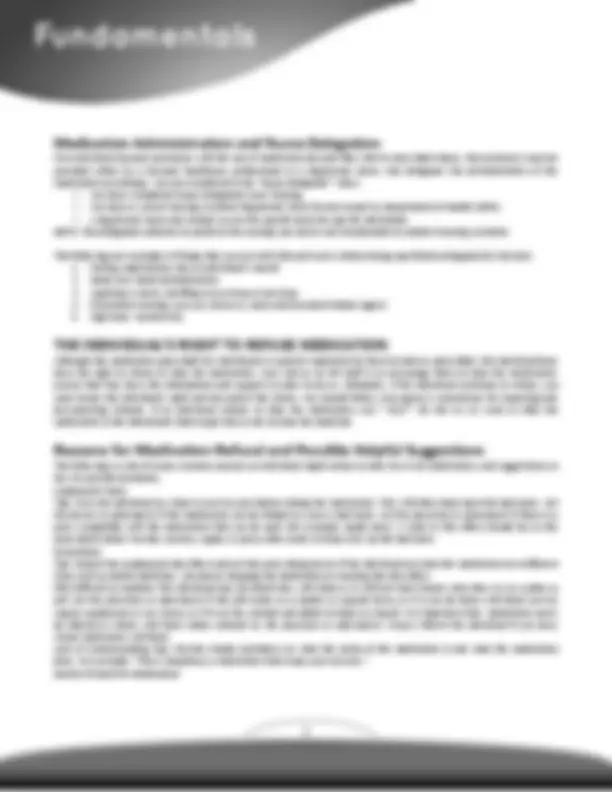
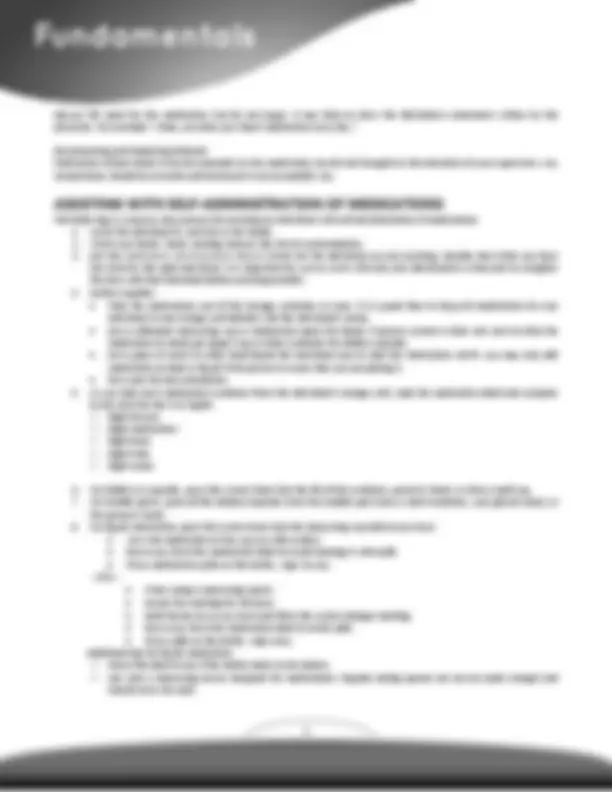
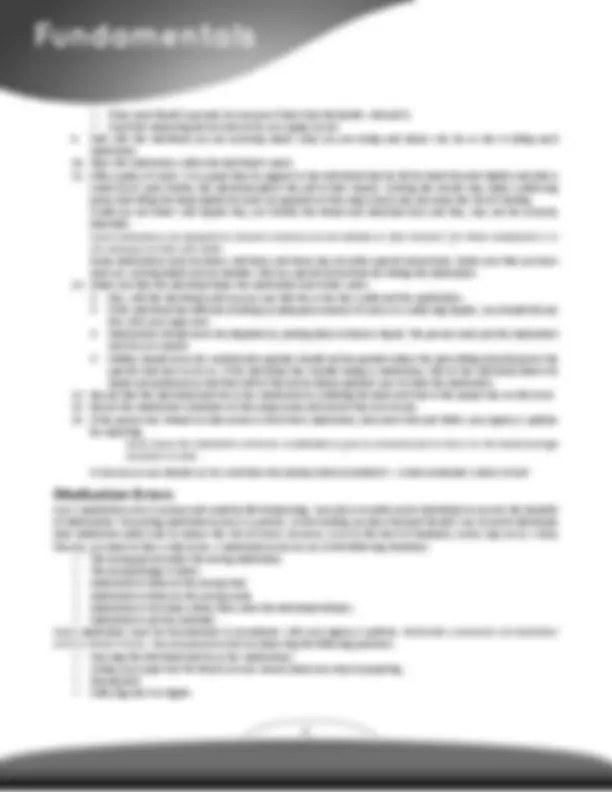
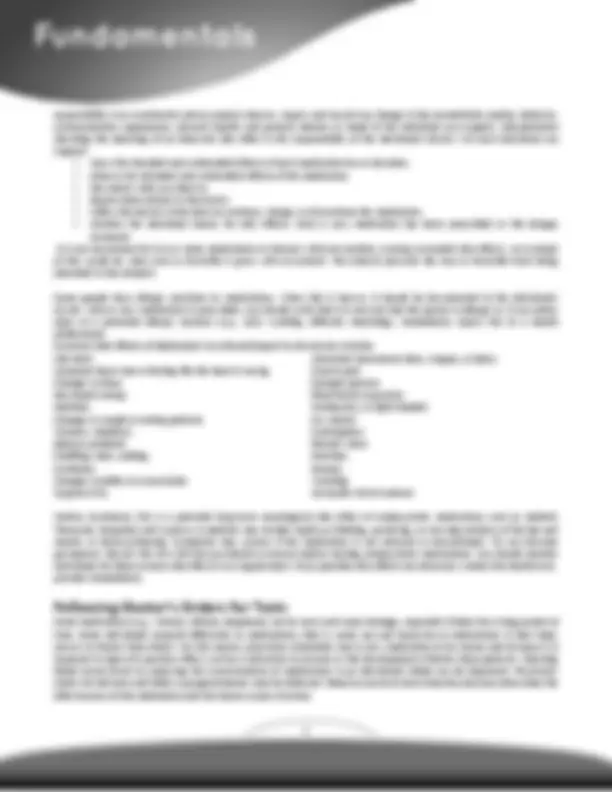
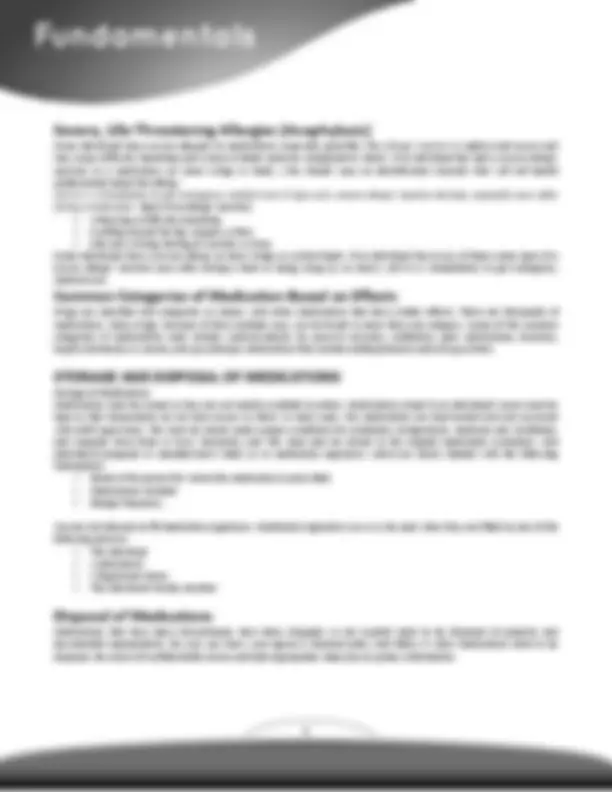


Study with the several resources on Docsity

Earn points by helping other students or get them with a premium plan


Prepare for your exams
Study with the several resources on Docsity

Earn points to download
Earn points by helping other students or get them with a premium plan
Community
Ask the community for help and clear up your study doubts
Discover the best universities in your country according to Docsity users
Free resources
Download our free guides on studying techniques, anxiety management strategies, and thesis advice from Docsity tutors
Essential information for individuals assisting with medication administration for individuals receiving supported living residential services. Learn about different types of medications, requirements for assisting, and steps for self-administration. Ensure the health and wellbeing of those you serve by understanding medication purposes, side effects, and prevention of errors.
Typology: Summaries
1 / 9

This page cannot be seen from the preview
Don't miss anything!






Allergic Reaction : a reaction caused by an unusual hypersensitivity to a medication (allergic reactions can also occur with foods, animals and other environmental substances). Counter Indicative : a condition or factor that increases the risks involved in using a particular drug or engaging in a particular activity (e.g., smoking). Drug : a word often used interchangeably with the word medication. Generic Name : t he name given by the federal government to a drug. Medication : substance taken into (or applied to) the body for the purpose of prevention, treatment, relief of symptoms, or cure. Medication administration : the direct application of a prescribed medication—whether by injection, inhalation, ingestion, or other means—to the body of the individual by an individual legally authorized to do so. Medication assistance : assistance with self-administration of medication rendered by a non-practitioner to an individual receiving supported living residential services and supports. Medication (Drug) Interactions : the result, either desirable or undesirable, of drugs interacting with themselves, other drugs, foods, alcohol, or other substances (e.g., herbs or nutrients). Medication Error : any time the right medication is not taken as prescribed. Nurse Delegation : the procedure following a specific set of guidelines and standards that allow staff with a prescribed training and certification to perform medical tasks. Ophthalmic : referring to the eyes. Otic : referring to the ears. Over-the-Counter (OTC) Medications : all nonprescription medications including aspirin, antihistamines, vitamin supplements, and herbal remedies. Pharmacist : licensed individual who prepares and dispenses drugs and is knowledgeable about their contents. Physician/Doctor : an individual licensed to practice medicine; for the purpose of prescribing medications only, the term is interpreted to mean any health care professional authorized by law to prescribe drugs: physician, dentist, optometrist, podiatrist, and nurse practitioner or physician’s assistant (who write prescriptions is acting under the supervision of the individual’s physician). Prescription Medications : medications that must be ordered by a physician or other licensed health care professional with authority to write prescriptions, such as a dentist or nurse practitioner. PRN (pro re nata) Medications : means that the medication is taken as needed to treat a specific symptom; PRN medications include both prescription and over-the-counter (OTC) medications. [Note: all PRN’s must be documented on the Medication Administration Record (MAR).] Psychoactive : possessing the ability to alter mood, anxiety level, behavior, cognitive processes, or mental tension; usually applied to pharmacological agents. Psychoactive Medications : refers to medications prescribed to treat a mental illness, improve functioning, or reduce challenging behaviors.; psychoactive medications include antipsychotics/neuroleptics, atypical antipsychotics, antidepressants, anticonvulsants, stimulants, sedatives/hypnotics, and anti-mania and anti-anxiety drugs; anticonvulsants and other classes of drugs are included in this category when they are prescribed for behavioral purposes. [Note: If a
psychoactive medication is used solely to treat a physical condition (e.g., sleep aid, seizures) or dementia, and is not also used to treat a mental illness or for challenging behavior, it is not considered a psychoactive medication.] Side Effects : unintended effects produced by medication other than those for which it was prescribed; sometimes side effects, such as a severe allergic reaction, can be deadly. Topical : applied to a certain area of the skin. Trade Name/Brand Name : the name given by the manufacturer to a medication.
Medication Assistance Many of the individuals you support take one or more medications on an ongoing basis. Some of you have been assisting with medication for a long time; for others, this may be a new responsibility. Whatever your level of experience, assisting with medication is a very important activity. The critical skills you will learn are designed to increase safety and reduce the risk of error, thereby providing maximum protection for the individuals you assist as well as yourself. No one wants to be responsible for causing injury or harm to someone else. The information being shared in this training will help prevent that. The health of many individuals you support depends on your skills in assisting them in taking medications. Your role in assisting individuals to take the right medication, in the right dose, by the right route, and at the right time is a very important function. Medications are substances taken into (or applied to) the body for the purpose of prevention, treatment, relief of symptoms, or cure. Knowing about medications, their use and abuse, and how to assist individuals in using them is vital to the health and wellbeing of those you serve. Some people you support may be independent in all aspects of taking their medications. This means that they maintain their medications independently and are responsible for ensuring they take the medications as prescribed. When this is the case, it will be documented in the person’s individual support plan.
Requirements for Assisting with Medications DDA Policies and Board of Pharmacy regulations are very specific regarding requirements for assisting with medications. You may only assist individuals with self-administration of medications that have been ordered and prescribed by a doctor, dentist, or nurse practitioner. This includes both prescription and over the-counter medications. The doctor’s signed and dated order or prescription provides instructions for preparation and administration of the medication.
Self-Administration of Medications Unless you are a licensed health professional, or have been authorized and trained to perform a specifically delegated nursing task, you may only assist the individual to take medications. Assisting with medications includes: Communicating the prescriber’s order to the individual in such a manner that s/he self-administers his/her medication properly. Reminding or coaching the individual when it is time to take a medication. Opening the individual's medication container. Handing the individual the medication container. Placing the medication in the individual's hand. Transferring medication from one container to another for the purpose of an individual dose (e.g., pouring a liquid medication from the container to a calibrated spoon or medication cup or using adaptive devices). Altering a medication by crushing, mixing, etc., as long as the individual is aware that the medication is being altered or added to food or beverage. A pharmacist or other qualified practitioner must determine that it is safe to alter a medication and this must be documented on the prescription container or in the individual’s record. Guiding or assist the individual to apply or instill skin, nose, eye, and ear preparations.
Discuss the need for the medication, but do not argue. It may help to show the individual a statement written by the physician. For example: “Alma, you take your heart medication every day.”
Documenting and Reporting Refusals Medication refusal needs to be documented on the medication record and brought to the attention of your supervisor. Any unused dose should be set aside and destroyed in an acceptable way.
The following is a step-by-step process for assisting an individual with self-administration of medications.
If too much liquid is poured, do not pour it back into the bottle—discard it. Wash the measuring device and air dry on a paper towel.
Every medication error is serious and could be life threatening. Your job is to safely assist individuals to receive the benefits of medications. Preventing medication errors is a priority. In this training you have learned the best way to assist individuals take medication safely and to reduce the risk of errors; however, even in the best of situations, errors may occur. When they do, you need to know what to do. A medication error occurs in the following situations: The wrong person takes the wrong medication. The wrong dosage is taken. Medication is taken at the wrong time. Medication is taken by the wrong route. Medication is not taken (other than when the individual refuses). Medication is not documented. Every medication must be documented in accordance with your agency’s policies. Remember: prevention of medication errors is the #1 Priority. You can prevent errors by observing the following practices: Knowing the individual and his or her medications Asking your supervisor for help if you are unsure about any step in preparing, Staying alert Following the Five Rights
Oral medications (capsules or tablets) are usually prescribed in mg (milligrams) or gm(grams). Liquid medications are usually prescribed in ml (milliliters), cc (centimeters), or oz(ounces). Liquid medications may also be prescribed in tsp (teaspoon), or Tbsp (tablespoon).
Medication safety includes learning about the medications that you are assisting another to take. Know the answers to all of the following questions: What is the medication, and why is it prescribed? What are the proper dosage, frequency, and route for taking the medication (for example by mouth, topical)? How many refills are authorized? What are the start and end dates for the medication? Should it be taken for 7 days, 10 days, or ongoing? Are there possible side effects? If so, to whom should these side effects be reported? What should be done if a dose is missed? Are there any special storage requirements? Are there any special instructions for use of this medication? For example, should certain foods, beverages, other medicines, or activities be avoided? What improvements should be expected, and when will they start showing?
Most of this information can be obtained by reading the individual’s record. Other sources of information include medication reference books from your local library or bookstore. Websites such as safemedication.com or rxlist.com also provide medication information. If you do not find this information in the record, follow your agency’s policies to obtain the information. You should know why medications are prescribed (their purpose) and what they are intended to do, so that you can monitor how effective they are. If a medication is not effective, this should be reported to your supervisor and to the individual’s prescriber so that it can be addressed. Some medications take longer than others in order to be effective. Your role is to monitor, document and report the effectiveness.
Side Effects of Medication The unintended effects of medication, called side effects , can occur at any time. Some mild side effects may disappear after a short time. Others will persist the entire time the medication is taken and sometimes beyond. Some side effects are mild, while others are life threatening. In the home where you work, it is important to learn about the medications each individual is taking. It is also important to know what possible side effects may occur. Be sure to ask the doctor what kind of reactions should be brought immediately to his or her attention. The pharmacy is a good source for information on the effects of medication. Medication information sheets should come with every new medication. Physical and behavioral changes that are due to the effect of a medication are often difficult to identify. There may be many different reasons for the same sign or symptom. A change in behavior may be due to a medication change or a change in the person’s environment. A sore throat may be one of the first symptoms of a cold or may be a side effect of a medication. Your
responsibility is to consistently and accurately observe, report, and record any change in the normal daily routine, behavior, communication, appearance, physical health, and general manner or mood of the individual you support. Interpretation (deciding the meaning) of an observed side effect is the responsibility of the individual’s doctor. For each individual you support: Know the intended and unintended effects of each medication he or she takes. Observe for intended and unintended effects of the medication. Document what you observe. Report observations to the doctor. Follow the doctor’s directions to continue, change, or discontinue the medication. Monitor the individual closely for side effects when a new medication has been prescribed or the dosage increased. It is not uncommon for two or more medications to interact with one another, causing unwanted side effects. An example of this would be when iron or Penicillin is given with an antacid. The antacid prevents the iron or Penicillin from being absorbed in the stomach.
Some people have allergic reactions to medications. When this is known, it should be documented in the individual’s record. When a new medication is prescribed, you should verify that it is not one that the person is allergic to. If you notice signs of a potential allergic reaction (e.g., rash, swelling, difficulty breathing), immediately report this to a health professional. Common Side Effects of Medication You Should Report to the Doctor Include: Skin Rash Increased heart rate or feeling like the heart is racing Changes in sleep Decreased energy Sedation Changes in weight or eating patterns Tremors, shakiness Balance problems Shuffling when walking Confusion Changes in ability to concentrate Hyperactivity
Abnormal movements (face, tongue, or body) Muscle pain Stooped posture Blank facial expression Feeling dizzy or light-headed Dry mouth Constipation Blurred vision Diarrhea Nausea Vomiting Increased risk of sunburn
Tardive Dyskinesia (TD) is a potential long-term neurological side effect of antipsychotic medications such as Mellaril, Thorazine, Risperdal, and Zyprexa. Symptoms may include rapid eye blinking, puckering, or chewing motions of the lips and mouth, or facial grimacing. Symptoms may worsen if the medication is not reduced or discontinued. TD can become permanent. Discuss this risk with the psychiatrist or doctor before starting antipsychotic medications. You should monitor individuals for these serious side effects on a regular basis. If any possible side effects are observed, contact the health care provider immediately.
Some medications (e.g., Tylenol, Lithium, Depakene) can be toxic and cause damage, especially if taken for a long period of time. Some individuals respond differently to medications; that is, some use and break down medications in their body slower (or faster) than others. For this reason, physicians sometimes start a new medication at low doses and increase it in response to signs of a positive effect, such as a reduction in seizures or the development of better sleep patterns. Checking blood serum levels by analyzing the concentrations of medications in an individual’s blood can be important. Physicians’ orders for lab tests and follow up appointments must be followed. Blood serum level tests help the physician determine the effectiveness of the medication and the future course of action.